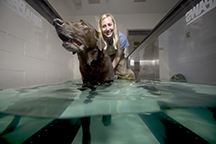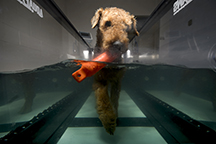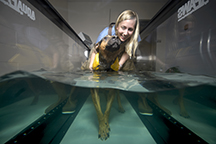February 4, 2016
Veterinary Teaching Hospital's underwater treadmill aids recovering canine patients
 |
|
Jessica Bowditch, a veterinary neurology and physical rehabilitation technician, works with Charley, a Labrador Retriever, in the underwater dog treadmill at the Purdue University Small Animal Hospital. The treadmill helps rehabilitating dogs and also can be used for dogs who need a different way to exercise. (Purdue University photo/Charles Jischke) |
WEST LAFAYETTE, Ind. — The Veterinary Teaching Hospital in Purdue University's College of Veterinary Medicine has an underwater treadmill for dogs.
The submerged treadmill can be particularly helpful for rehabilitating dogs and also can be used for dogs who simply need a different way to exercise.
"The benefit for dogs using an underwater treadmill is similar to walking under water for humans," said Stephanie Thomovsky, a board-certified clinical assistant professor of veterinary neurology and neurosurgery who leads the hospital's Physical Rehabilitation Service. "If you walk in the water it's more difficult due to resistance, but there is less stress on the joints due to buoyancy. The buoyancy makes our patients lighter and puts less stress on dogs recovering from both orthopedic and neurologic surgeries or those with osteoarthritis.
"Also, we keep the water warm. It's usually about 88 degrees, so that will increase blood supply to the limbs. That also helps in the recovery."
The hospital installed the underwater treadmill in October as part of the new rehabilitation service. The treadmill is housed in a large tank in the Small Animal Hospital. It's connected to a large water tank and filters in the adjoining room.
Jessica Bowditch, a veterinary neurology and physical rehabilitation technician, works with dogs in the treadmill and also takes care of the tank and water supply, adding chemicals and changing filters when needed.
 |
|
Force, an airedale who participates in canine agility competitions, gets some exercise in the underwater dog treadmill at the Purdue University Small Animal Hospital. (Purdue University photo/Charles Jischke) |
"It's like my little swimming pool," she said.
Many of the dogs that use the device are post-operative orthopedic and neurologic patients, and it can aid in more than just the physical recovery.
"There's a psychological benefit to get our patients to use their legs and get them to be able to walk and stand at home," said Thomovsky, who also is a certified canine rehabilitation practitioner. "Many of these dogs haven't walked or been on their feet for a while, so therapy in the underwater treadmill helps them work on an appropriate posture for standing and walking. The dogs realize their feet are touching the ground, and then they get the idea that they can stand and walk."
In addition to being used to support the recovery of hospital patients, the underwater treadmill also can be used for dogs that are referred for physical rehabilitation, Bowditch said.
It also can be used in other kinds of cases, Thomovsky said.
"The treadmill can help obese and arthritic dogs exercise due to there being less stress on joints in the water," she said. "The buoyance of the water helps them feel better. There could be increased use of it in the winter. It's good for agility dogs who can't swim in the cold water during winter months like they do regularly in summer months, or if it's icy and dogs can't go for walks, they could walk and exercise here."
 |
|
Jessica Bowditch, a veterinary neurology and physical rehabilitation technician, works with Tigger, a pit bull mix, in the underwater dog treadmill at the Purdue University Small Animal Hospital. (Purdue University photo/Charles Jischke) |
Most dogs take to the underwater treadmill without any issues.
"I've not had any trouble getting dogs to use it," said Bowditch, who usually gets in the tank with most of the canines. "I have had some dogs that sort of have a look like, 'What is that?' But, usually, you put them in and they're fine. The biggest problem is when they get in the treadmill and don't do anything, but that doesn't happen often."
Some dogs do need to take it easy at first.
"The dogs that don't get much regular exercise, like those that sit on the couch a lot, you have to be careful with their cardiovascular and breathing, at first," Thomovsky said. "It's like humans and the warning on treadmills about consulting a physician before using them. In some situations you're doing more to build up strength and in some you're working on cardio."
The Purdue Physical Rehabilitation Service was started just over one year ago after Thomovsky joined the Purdue faculty. Eight months later, Bowditch was hired and joined the service. Eventually both hope the college will be able to offer physical rehabilitation as a block that fourth-year veterinary students and veterinary technicians can rotate through and learn things such as how and when to utilize an underwater treadmill for canine patients.
Writer: Greg McClure, 765-496-9711, gmcclure@purdue.edu
Sources: Stephanie Thomovsky, 765-494-1100, sthomovs@purdue.edu
Jessica Bowditch, 765-494-8495, jjtong@purdue.edu
Kevin Doerr, public affairs and communications for the College of Veterinary Medicine, 765-494-8216, doerrk@purdue.edu

